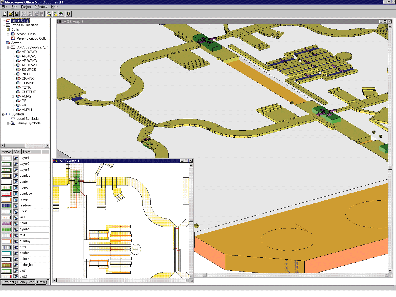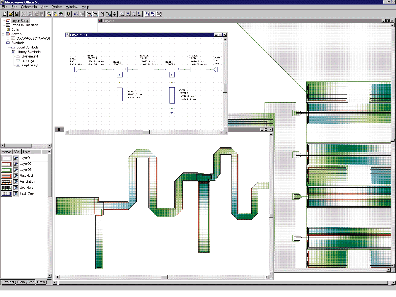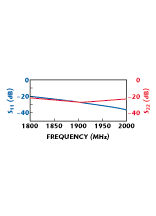Low Cost, Surface-mount RF Amplifiers for PCS Base Station Use
Micro-Precision
Technologies Inc.
Salem, NH
Personal communications service (PCS) base station transmitter and receiver designs frequently require amplifiers that simultaneously exhibit a combination of low noise and excellent linearity and impedance match. Silicon and GaAs MMICs exhibit some of these characteristics, but not the entire combination. Hybrid amplifier designs frequently offer the best performance but are prohibitively expensive for some applications. Thermal issues are important as well. Although they are convenient to use, typical MMICs exhibit high thermal impedance and may not be suitable for use in wide temperature range applications that require high linearity. For the highest linearity requirements, hybrid amplifiers, which can be heat sunk to a chassis, typically are the best choice. As a result, a niche market exists for applications that require more performance than a MMIC without the added cost or performance of a chassis-mount hybrid.
A surface-mount hybrid can be used to fill this niche in a cost-effective manner. This hybrid can be designed with excellent thermal and electrical performance while retaining the convenience of a true surface-mount component. While this hybrid is higher in cost than a plastic-package MMIC, the performance also can be correspondingly higher. As a result, the performance range that is attainable for circuits built entirely using surface-mount components can be extended and, in some cases, the need for chassis-mount components can be eliminated.
 Two new surface-mount RF amplifiers have been designed for PCS base station use. The models LNA1 and LNA2 low noise, high dynamic range amplifiers cover the 1800 to 2000 MHz frequency range with typical noise figures of 1.1 and 1.2 dB, respectively,
Two new surface-mount RF amplifiers have been designed for PCS base station use. The models LNA1 and LNA2 low noise, high dynamic range amplifiers cover the 1800 to 2000 MHz frequency range with typical noise figures of 1.1 and 1.2 dB, respectively,  as shown in Figure 1 . The LNA1 amplifier offers a typical gain of 18 dB and third-order intercept (IP3 ) of 32 dBm, as shown in Figure 2 . The LNA2 amplifier features a typical gain of 31 dB and IP3 of 39 dBm, as shown in Figure 3 . Both amplifiers are powered from +5 and -5 V DC
as shown in Figure 1 . The LNA1 amplifier offers a typical gain of 18 dB and third-order intercept (IP3 ) of 32 dBm, as shown in Figure 2 . The LNA2 amplifier features a typical gain of 31 dB and IP3 of 39 dBm, as shown in Figure 3 . Both amplifiers are powered from +5 and -5 V DC  supplies. The LNA1 draws approximately 65 mA and the LNA2 draws approximately 215 mA from the +5 V supply. Both amplifiers draw less than 5 mA from the -5 V supply. Typical input and output return losses for the LNA1 and LNA2 amplifiers are 20 and 15 dB, respectively. Figure 4 shows the return losses for the LNA1
supplies. The LNA1 draws approximately 65 mA and the LNA2 draws approximately 215 mA from the +5 V supply. Both amplifiers draw less than 5 mA from the -5 V supply. Typical input and output return losses for the LNA1 and LNA2 amplifiers are 20 and 15 dB, respectively. Figure 4 shows the return losses for the LNA1  amplifier.
amplifier.
The amplifiers are entirely self-contained and require no external components. Internal bias sequencing and regulation circuits allow the bias supplies to be applied in any order without causing damage. The amplifiers operate over a -40° to +85°C temperature range and will work properly from a positive DC voltage of 3.5 to 6 V. Nominal amplifier performance is specified at 25°C and +5 V DC.
The amplifiers are housed in surface-mount packages with compliant leads that are coplanar to within ±2 mils. The circuits are constructed on a ceramic substrate using 2- to 3-mil lines/spacing of a new thick-film technology for good performance, ruggedness over wide temperature ranges and cost effectiveness. The LNA1 and LNA2 amplifiers measure approximately 0.800" x 0.800" x 0.175" and have 18 leads with a lead pitch of 0.100".
These amplifiers have been designed to provide cost-effective solutions for PCS base station applications. As such they do not provide the lowest noise or the highest possible linearity, but they do offer the best achievable compromise at the lowest possible cost. The LNA1 and LNA2 amplifiers cost approximately $20 and $30, respectively, in volume quantities.
Micro-Precision Technologies Inc.,
Salem, NH
(603) 893-7600.
